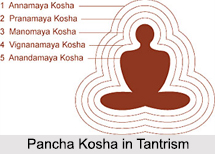 Brahma-Para or the city of Brahman is the human body that enjoys a highly significant place in Tantra. Although the body is real and restricted by its faculties, the supreme Brahman is garbed in the five sheaths or the "Pancha Kosha" of the body, and merely appears limited by its garments. In Tantra and Hinduism in general, even God is said to enter the universe in a human body, as a Jiva or the immortal essence of a living entity.
Brahma-Para or the city of Brahman is the human body that enjoys a highly significant place in Tantra. Although the body is real and restricted by its faculties, the supreme Brahman is garbed in the five sheaths or the "Pancha Kosha" of the body, and merely appears limited by its garments. In Tantra and Hinduism in general, even God is said to enter the universe in a human body, as a Jiva or the immortal essence of a living entity.
Pancha Kosha
The five sheaths or Pancha Kosha are each means by which the supreme Brahman interacts with the universe that it pervades. They are:
•Anna Maya Kosha,
•Prana Maya Kosha,
•Vijnana Maya Kosha,
•Mano Maya Kosha
•Ananda Maya Kosha.
In the first physical sheath (or body), the Brahman is self conscious of its physical attributes, like height, colour, girth and weight. In the Prana-Maya Kosha, or vital body, it feels hunger, thirst and desire. It thinks and understands through the mental bodies of the Vijnana-Maya Kosha and the Mano-Maya Kosha. In the last, the Ananda-Maya Kosha, the Brahman resides in perpetual bliss. Each of these garments hence renders for the Brahman a unique experience of the universe.
A description of each of the Koshas is as follows:
Anna Maya Kosha: The material body or the food sheath (anna) is linked in Tantra to the lowest chakras; i.e. the Mooladhara, the Swadhisthana and the Manipura centres. It is linked to the principles of earth, fire and water and both physical attributes (like hair, skin and blood) and the senses (hearing, seeing, tasting) are linked to it. In short, it is the physical body sans spiritual or mental attributes.
Prana Maya Kosha: The "breath" sheath, or vital body, is that in which prana is predominant, found in air or ether, and linked to the higher chakras; i.e. Visuddha and Anahata. The prana is not merely air but a vital universal force that is essential for several bodily functions. The Prana Maya Kosha enables the Brahman to feel alive; it is an animating principle.
Mano Maya and Vijnana Maya Kosha: Both the Mano Maya and Vijnana Maya constitute a human"s inner cognitive functions, called the Antah-Karana in Hinduism. The antah-karana is four-fold comprising manas, buddhi, ahankara and chitta. The antah-karana is linked to the higher Ajna Chakra and below the Sahasrara lotus. This subtle body, consisting of the Mano Maya and Vijnana Maya Kosha, contain within it the cause for the body"s rebirth into subsequent lives.
Ananda Maya Kosha: The Ananda Maya Kosha is the fifth sheath of the human body, in which the Brahman resides in bliss. The Atma resides in this sheath of bliss, although it has three states, the wakeful, dreaming and dreamless sleep. This Kosha is linked directly to the Sahasrara chakra, the highest. Each state of the atma is linked to the antah-karana, the waking state that involves the sense organs and external activities which the manas leaves as sense impressions in the mind, the dreaming state involves the buddhi aspect of the antah-karana, that works on the impressions left by the manas during the waking state. In dreamless sleep, both manas and buddhi are suppressed. Still other states exist, and the atma progresses from each state to the other in its residence in the Ananda Maya Kosha.
The human body is a vivid, complex entity in Tantra; and its principles can be seen to have close counterparts in modern biology and psychology. It is also a sanctum for the universal Brahman, thus rendering it integral to Tantra practice.




















